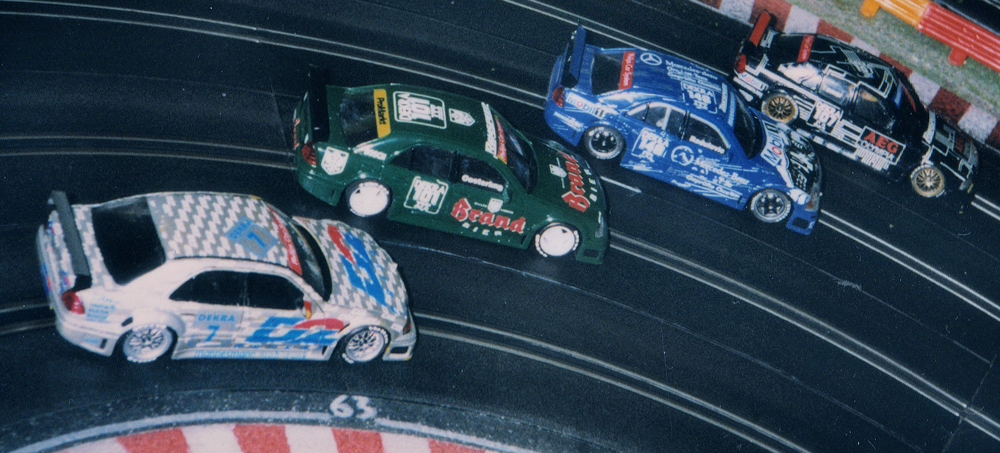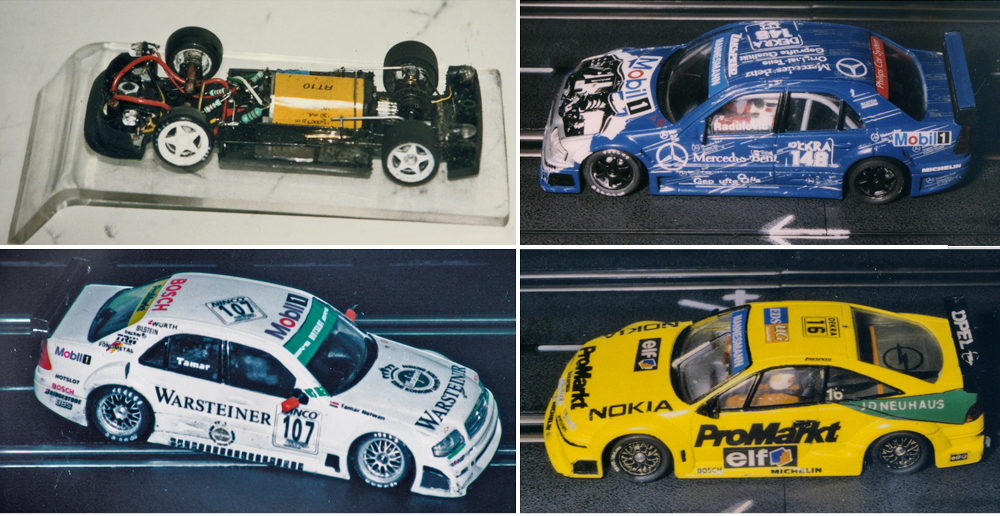It recalls some nice moments shared with some of this site's oldest members and some of the really old school techniques of tuning a Ninco DTM slot car.
Camber wheels as performance enhancer #1:" the placebo effect"
I.m.o if it looks better it must be faster,
Love the pictures of the NSU chassis, too bad there were no images of a chassis with a mounted body..but here's the real deal.
Anything that makes a slotcar look more like the real deal is an Performance enhancer in my book...as it will make me drive faster


Now that Scalex and Slot.it have rediscovered tin tops, the content of the pictures I've posted below has become relevant again.
So lets turn back the clock two decades when these cars were brand new and the hottest tintops around.
We're talking 1995, a pivotal year where the DTM was at its pinnacle of popularity, transformed into a world series (ITC) only to imploded after two seasons.

For 1/32nd slotracers it was the beginning of a new era as Ninco had finally completed its holy trio of DTM slotcars, the Alfa, the Benz and the Calibra.
Believe it or not in those days, with the new Ninco NC2 motor, these were the hottest slotcars you could race.
But that did not stop us from tweaking the hell out of them.
Camber wheels as performance enhancer #2:"Outriggers and independent spinning fronts"
In those days most of the clubs in Holland were running on Fleischmann track and used a wide variety of petroleum and oil base products to make their hard Ninco tyres grip.
As a result most tracks were covered under a thick layer of oily tyre residu, we were not running on a plastic...we were running on rubber

High grip and top heavy cars, the default set up was to run slightly on your front wheels using them as outriggers to keep the cars from topling over.
This was pre grub screw era, so a brass tube across the front axle mounts was "the" thing to do.
Running on the fronts meant they picked up rubber, so it did not take that long before we started to cut the axle and tube in two to create independent spinning front wheels....

...the next logical step was to add camber. By mounting the stub axles at an angle we increased the front track from 58 to 60 mm which improved the stability at the front.
The camber also kept the top of the wheels nicely tucked within the arches while running with a bit of body float, the added clearance also meant we could run the cars at a much lower GC than the stock Ninco rideheight. With the Fleischmann track being much smoother than Ninco we had a min GC at the front of 0,5mm
All in all these mods were good for an 0,3- 0,5 sec gain over a 9,5 sec lap.
Below left is an image of such a cambered front axle, K&S 1/8 brass tube was cut into two 10mm lenghts for the stubs and two 3mm lenghts for the axle stoppers.
A 1,5mm piece of brass wire was bent into a U shaped brace, the legs were soldered to the middle of the 10 mm stubs. The stoppers were glued or soldered to the stub axles.
The front wheels were trued conical so that only the outer edges of the tyres touched the track.
With the assembly complete you could bend the U brace to give the stubs the desired camber.
The stubs were "tack glued" in the front axlemounts at the desired ride heigth, the base of the U- brace was then epoxy glued to the bottom of the chassis.
Camber wheels as performance enhancer #3:"Toe in, toe out"
Less conclusive was the application of Toe in or toe out, although trhere were firm believers in both options.
The general idea was that as the car started to lean on the outside wheel in the corners, toe in was good for a better turn in, while toe out helped counter power oversteer as the car came out of the corner.
In the pictures below are examples of both.

The same techniques were used when with the advent of Ninco and Fly the racing swayed from individual sprints with Touringcars to Team endurance races with GT's.
Long wheelbased cars would run with a bit of toe in and short wheelbased cars opted for toe out.

Cambered rear wheels as performance enhancer?:"Theoretical"
Besides fitting for a classic NSU it would certainly look good on any Porsche GT, so the Placebo effect is there
And as Dopamine wrote, there are track conditions where a cambered tyre profile would have its benefits.
Those who have read the "Tyre idiot guide" topic will be aware of the arguments for the benifits of a wide footprint in the corners and a smaller footprint with a larger diameter on the straights.
The wider track width would help in some cases, but I guess the biggest advantage will be had by the extra clearance the cambered rears would give you in body float.
If these theoretical benifits outweigh the extra friction of the axlejoint and the angled driveshafts remains to be seen (as nobody has track tested this configuration yet)
The BRM brass kit looks rather massive and chunky..and that's for a 1/24 chassis, time for a Maurizio "what if " moment?


